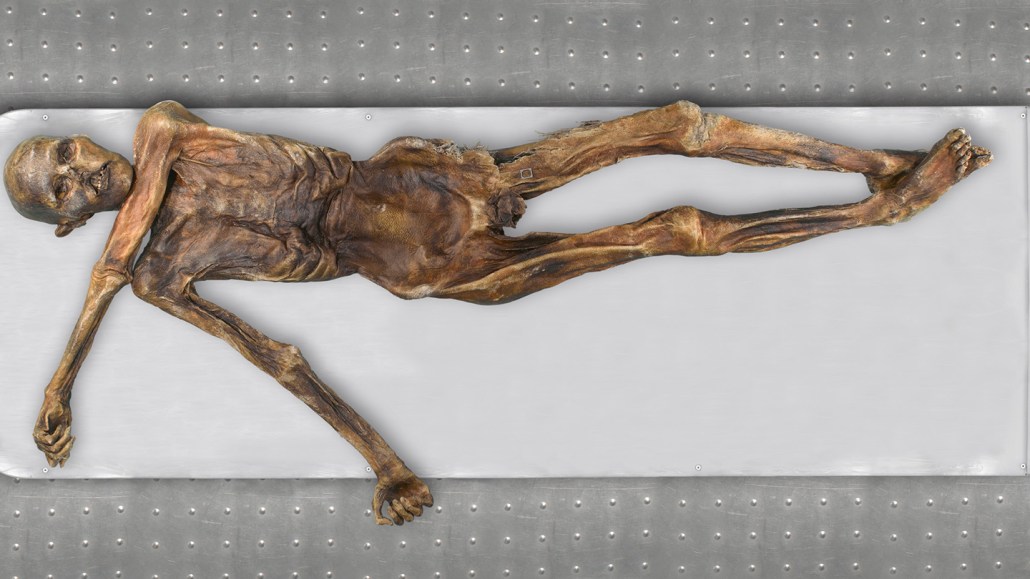Ötzi the Iceman’s DNA reveals his looks and ancestry
The guy was balding, dark-skinned and didn’t have the ancestors scientists had expected

The Iceman mummy’s skin is obviously dark. Scientists used to think that was a result of being frozen in a glacier for more than 5,000 years. A new genetic analysis reveals that in life, Ötzi also was dark-skinned.
Südtiroler Archäologiemuseum, Marco Samadelli/EURAC, Gregor Staschitz
Share this:
- Share via email (Opens in new window) Email
- Click to share on Facebook (Opens in new window) Facebook
- Click to share on X (Opens in new window) X
- Click to share on Pinterest (Opens in new window) Pinterest
- Click to share on Reddit (Opens in new window) Reddit
- Share to Google Classroom (Opens in new window) Google Classroom
- Click to print (Opens in new window) Print
Listen to this story:
Have feedback on the audio version of this story? Let us know!
In 2012, scientists sequenced the DNA of a mummy found in a glacier in the mountains along the border of Austria and Italy. The man — known as Ötzi (OOT-see) the Iceman — had been frozen for some 5,300 years. Now, a new look at his DNA reveals that Ötzi’s ancestors weren’t who scientists had thought.
The genetic analysis from 2012 had suggested Ötzi had ancestors from the Pontic-Caspian steppe. This vast area spans much of southeastern Europe. The scientists had found that Ötzi’s DNA looked a lot like that of people living on the island of Sardinia. Part of Italy, it’s in the Mediterranean Sea. That’s quite a hike from where Ötzi was found in central Europe.
Something just didn’t add up.
Other people with steppe ancestry didn’t appear in central Europe until about 4,900 years ago. Ötzi had been there earlier. He “is too old to have that type of ancestry,” says Johannes Krause. He’s a geneticist at the Max Planck Institute for Evolutionary Anthropology in Leipzig, Germany. There, he studies ancient humans and their DNA.
So Krause was part of a team that put together a new genome, or set of genetic instructions, for the Iceman. With this new analysis, “the steppe ancestry is completely gone,” Krause says. The old genome was heavily contaminated with modern people’s DNA.
The researchers shared their findings August 16 in Cell Genomics.
New insights emerge
The Iceman’s new genome reveals that Ötzi had male-pattern baldness, a type that’s inherited. He also was much darker-skinned than artists had depicted him in the past. Genes for light skin tones didn’t become prevalent until 4,000 to 3,000 years ago.
That’s when early farmers started eating plant-based diets. Eating less fish and meat than hunter-gatherers had, these people no longer got as much vitamin D, Krause explains. The nutrient is important for building bones and more.
Dark pigments help protect the skin from sunlight’s harmful ultraviolet rays. But people make vitamin D when exposed to sunlight. So dark skin can block how much vitamin D people can make. That’s not a problem in the sunny tropics. But for people living in areas that don’t get much sunlight, such as Europe, it helps if their skin has less pigment. And over many generations, people living in Europe developed light-colored skin, which helped them get enough vitamin D.
As Ötzi and other ancient people’s DNA illustrates, genes for light skin color took thousands of years to become common in Europe.
“People that lived in Europe between 40,000 years ago and 8,000 years ago were as dark as people in Africa,” Krause says. That makes a lot of sense because Africa is where humans came from, he explains.
“We have always imagined that [Europeans] became light-skinned much faster. But now it seems that this happened actually quite late in human history.”
About 90 percent of Ötzi’s genetic heritage now appears to come from farmers from the Late Stone Age. (That period started around 40,000 years ago.) That’s an unusually high amount, Krause says, compared with other human remains from the Copper Age in which Ötzi lived.







